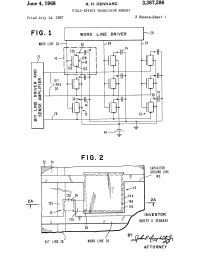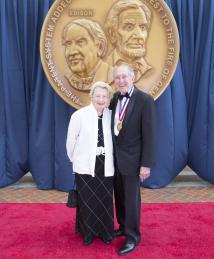Robert H. Dennard
"One of the best indications of my success came from the United States Patent and Trademark Office itself. I received a call from Washington one day asking that I send back my copy of the original patent they issued. Their copy had been run through the photocopier so often, it was no longer legible!"
Robert Heath Dennard invented one-transistor Dynamic Random Access Memory (DRAM), which significantly increased computer memory density while reducing costs. Considered one of the most important advances in computer technology, DRAM became the industry standard, enabled the microcomputer revolution and is commonly used in all forms of computers.
Dennard was born in Terrell, Texas, in 1932. He studied electrical engineering at Southern Methodist University, earning his bachelor’s degree in 1954 and his master’s degree in 1956. After earning his doctorate in electrical engineering from Carnegie Institute of Technology in 1958, he joined IBM's Research Division.
At IBM's Thomas J. Watson Research Center, Dennard began working on field-effect transistors, integrated circuit design, and memory cells and organizations in 1963.
In 1966, as Dennard had been contributing to the design of a new form of computer memory using silicon-based transistors, he developed an idea that would offer an alternative to the standard memory technology of the time – core memory, or magnetic data storage. “One day, I listened to a presentation from a competitor who was trying to extend magnetic memory,” Dennard later recalled in his National Inventors Hall of Fame® acceptance speech. “Their simple approach instantly challenged me to find a better way to do memory in our silicon chips. It came that very night.”
Dennard’s idea involved semiconductor technology with patterns of extremely small transistors, wires and other components that were etched in silicon. He realized he could store a bit with a single transistor by using a small amount of energy to repeatedly refresh the capacitor used to store the bit. This approach allowed substantial storage in a simpler, smaller circuit, and Dennard understood that as manufacturers could fit more transistors in smaller spaces, computers would become both faster and more affordable.
In 1968, Dennard received the patent for one-transistor DRAM. The first DRAM chips were brought to market by the early 1970s and soon became standard in nearly all computers. Early DRAM chips could store a kilobit, or 1,000 bits, of memory, and as the technology has evolved over decades, the storage capacity has grown significantly. Currently, 8-gigabit DRAM chips can be found in virtually all computers and smartphones around the world. By greatly increasing the capacity of digital information storage, Dennard’s foundational technology has had an indelible impact on society, driving progress and shaping the way we communicate, work and access entertainment.
“One of the best indications of my success came from the United States Patent and Trademark Office itself,” said Dennard. “I received a call from Washington one day asking that I send back my copy of the original patent they issued. Their copy had been run through the photocopier so often, it was no longer legible!”
A pioneer in scaling theory, which provides rules for making circuits smaller in every dimension, Dennard was named an IBM Fellow in 1979. He held more than 100 U.S. patents, and his many awards included the National Medal of Technology, the Harvey Prize, the IEEE Medal of Honor, the Draper Prize and the Kyoto Prize.

